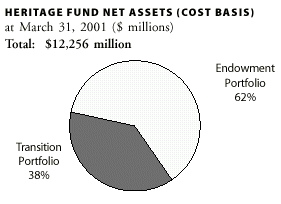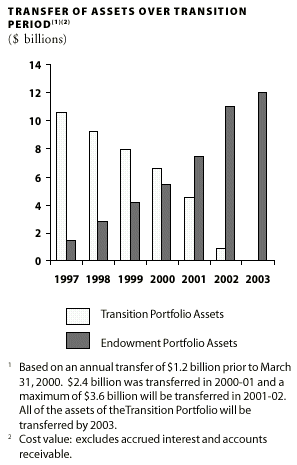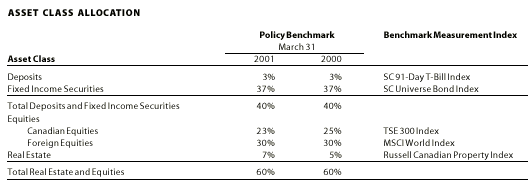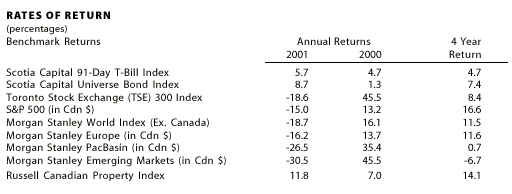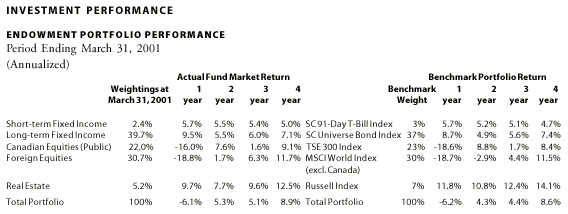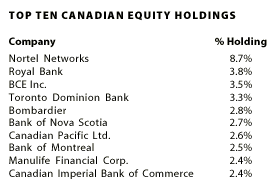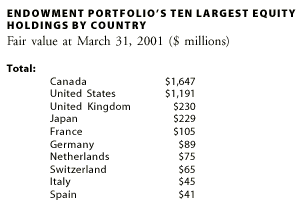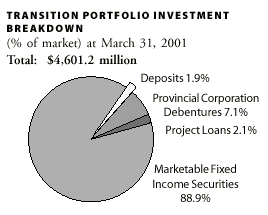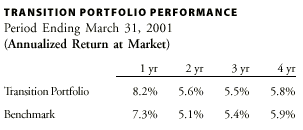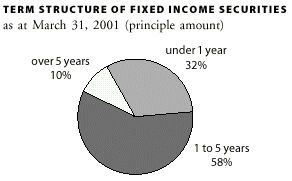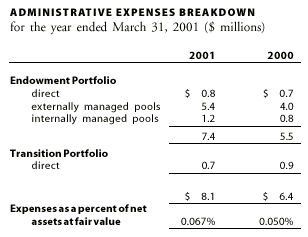|
|
|||
|
|
|||
|
June 25, 2001 If you would prefer to download this document as a pdf file, Click Here. Table of Contents - Part 1
Go to Part 2 (Financial Statements and Investments) Fund ProfileThe Fund, established in 1976, operates under the authority of the Alberta Heritage Savings Trust Fund Act. A new Act was passed and came into force on January 1, 1997 that sets out a revised investment framework for the Heritage Fund. The statutory mission of the Fund is: "To provide prudent stewardship of the savings from Alberta’s non-renewable resources by providing the greatest financial returns on those savings for current and future generations of Albertans." The Standing Committee on the Alberta Heritage Savings Trust Fund reviews and approves the business plan and annual report of the Fund. The Standing Committee has representation from the major parties of the Legislature. The Standing Committee receives regular reports on the performance of the Fund and conducts public meetings on an annual basis in different locations in the Province. The purpose of these meetings is to update Albertans on the management of the Fund and to solicit input from Albertans on the Fund’s objectives. On March 15, 2001, the government announced new ministry structures. As a result, responsibility for the Fund and its investments was transferred to the new Ministry of Revenue. The Minister of Revenue is required to report on the performance of the Fund quarterly within 60 days of the end of the quarter and make public the annual report within 90 days of the end of the fiscal year. The business plan of the Heritage Fund is published as part of the budget and the income of the Fund is consolidated into the revenue of the Province. An Investment Operations Committee was established to add private sector financial and business oversight of the Fund’s investment policies and operation. The Investment Operations Committee is chaired by the Deputy Minister of Revenue and consists primarily of private sector members. The Committee reviews and makes recommendations with respect to the business plan, annual report and investment policy statements for the Fund. The Committee meets at least quarterly to review performance and fund management. The investment portfolio of the Heritage Fund is managed by a group of highly qualified and experienced professionals in Alberta Revenue’s Investment Management Division. External specialist managers (private sector investment managers) are used to manage specific investment mandates. For the year ending March 31, 2001, the Fund’s total investment expense, for both externally and internally managed investments, was $8.1 million or .067% of the Fund’s total market value. The management of the fund is cost effective. The average investment expense paid by other institutional investors is 0.25% of total market value or the equivalent of $30.3 million. A savings of approximately $22.2 million to the Province. Minister of Revenue’s Report to Albertans on the Alberta Heritage Savings Trust FundIt’s an honour to report to Albertans on the performance of the Alberta Heritage Savings Trust Fund during the year of its 25th anniversary. The Heritage Fund has become a unique symbol of pride to Albertans and an illustration of forward thinking and long-range planning by government. As many Albertans know, the Heritage Fund was created in 1976, when the oil and gas sector was booming. Non-renewable resource revenue collected by the Alberta Government was reaching record highs, so the government decided to take some of those revenues and put them into an investment fund. The idea was, that there would be a source of revenue for the province to fall back on when oil and gas resources are reduced. The Heritage Fund started with an initial investment of $620 million and a special contribution of $1.5 billion. The Fund earned $88 million from investments during 1976-77, bringing the Heritage Fund’s total assets to $2.218 billion on March 31, 1977. As of March 31, 2001, the total fair value of the Fund is $12.1 billion and it earned $706.2 million in net investment income. The future of the Heritage Fund was reviewed in 1995. The Alberta Government surveyed Albertans and we were told to keep the Fund for future generations with a focus on earning greater returns on long-term investments, while providing a steady stream of income to help pay for current needs. To do this, a plan was put into place in 1997 to re-structure the Fund. The Fund was divided into two distinct portfolios: the Transition Portfolio to support the Province’s immediate fiscal needs; and the Endowment Portfolio to optimize long-term returns. With the decline in long-term interest rates, it was realized that the only way to provide a sustainable level of income in real terms was to invest in assets that would provide higher long-term returns. This would mean a portfolio with a significant commitment to equities. In keeping with what Albertans’ said, all of the $706.2 million that the Heritage Fund earned in 2000-01 was transferred to the province’s General Revenue Fund and used for Albertans’ priorities like health care, education, roads, tax reductions and debt repayment. We must recognize that in focusing more on achieving a higher long-term rate of return, we must accept increased risk and volatility in the Fund’s investment income from year to year. The key to achieving long-run, sustainable performance is to maintain a prudent diversified portfolio, a long-term focus, and investment discipline. And since the volatility in equity markets can produce fluctuations in performance from year to year, the performance of the Fund must be assessed over the long term. The Heritage Fund must be managed on a prudent basis. Key to that management is the measurement of performance against clearly defined benchmarks. As you may have noticed if you watch the markets, fiscal 2000-01 was a weak year in the world equity markets. The downturn in equity markets contributed to lower than expected investment income and a decline of 5.7% in the total fair value of the Fund from the previous year. However, the Fund is still exceeding its performance benchmarks. The Heritage Fund is an important part of the Province’s fiscal framework and represents an ongoing legacy for all Albertans. Earlier this year, both Moody’s Investor Services, and Standard and Poor’s announced they were boosting Alberta’s credit rating to triple A, higher than any other Canadian province. The long-term stability of the Heritage Fund is a key consideration in their reviews. The Heritage Fund is an important part of Alberta’s past, present and future. The future of the Heritage Fund will be explored again at the up-coming Future Summit where people from across Alberta will discuss and help develop a plan for a debt-free Alberta. [original signed] Honourable Greg Melchin
The Year in Review
Business PlanThe business plan for the Heritage Fund describes the mission and specific investment objectives of the Fund and how the Fund will be invested, managed and measured. The business plan is reviewed annually and is published as part of the budget. The Investment Operations Committee reviews and makes recommendations regarding the business plan and the investment policies for the Fund. The business plan is then reviewed and approved by the Legislature’s Standing Committee on the Alberta Heritage Savings Trust Fund. The Fund has been structured into two portfolios: the Transition Portfolio and the Endowment Portfolio. Each portfolio has its own investment objective and policy which is closely tied to the goals of the Fund. The three goals of the Fund, as outlined in the plan, remain as follows: Goal 1 - Earn income to support the government’s consolidated fiscal plan.
Goal 2 - Make investments in the Endowment Portfolio to maximize long term financial returns. The Endowment Portfolio focuses on the long term investment horizon. The Endowment Portfolio is being funded gradually over time with assets transferred from the Transition Portfolio. Eventually all Heritage Fund assets will be invested in the Endowment Portfolio. The investment policy for the Endowment Portfolio called for a long term policy allocation of 60% in equities. Further, the policy allocation to foreign equities is 30% of the Endowment Portfolio. Goal 3 - To improve Albertans’ understanding and the transparency of the Alberta Heritage Savings Trust Fund. This goal includes the timely release of quarterly reports and detailed discussion of the Fund within the Annual Report. In addition, the Standing Committee provides for ongoing public consultation through public meetings held throughout the Province on an annual basis. Each Portfolio of the Fund is compared to clearly defined performance benchmarks.
Transfer of Income to the General Revenue Fund The Alberta Heritage Savings Trust Fund Act provides for the transfer of Heritage Fund income to the General Revenue Fund. On March 23, 1999, the Fiscal Responsibility Act received Royal Assent and, until the accumulated gross debt is eliminated, the Minister of Revenue may retain in the Fund such amounts as the Minister of Revenue considers advisable. Endowment PortfolioIntroduction The Endowment Portfolio was established on January 1, 1997 with a transfer from the "old" Heritage Fund of $1.2 billion of investments (at cost). This included equity holdings previously held in the former Commercial Investment Division and a mix of short term and mid term fixed income securities. Since the initial $1.2 billion funding, the Endowment Portfolio has received monthly transfers from the Transition Portfolio. At March 31, 2001, the fair value of the portfolio was $7.5 billion. The Endowment Portfolio has undergone considerable change as the initial assets and subsequent cash flow have been invested to meet the policy objectives. Investment Objective The investment objective of the Endowment Portfolio is to optimize long term financial returns subject to an acceptable level of risk. Alberta Revenue operates under the "Prudent Person Rule" by legislation. This assigns to the investment manager the responsibility to restrict investments to assets that would be approved by a prudent investor. By investing to optimize long term returns it is expected that over time, the Heritage Fund will generate higher financial returns than in the past when social and economic objectives were pursued or if only shorter term income objectives were pursued. Similar investment funds with long term investment horizons and an objective to optimize long run returns, invest a significant amount of their assets in equities since equities have historically provided investors with higher total returns (dividends and capital gains) than interest bearing investments. This results in more volatility in capital gains and less interest income. Based on historical experience, a similar asset mix policy would have generated a real rate of return of around 5.0%. The return in each asset class is compared to a market benchmark. The performance of the Endowment Portfolio will be measured by comparing the actual return of the fund to the return generated by a benchmark portfolio asset mix. It is calculated by multiplying the returns achieved by market indices by the Portfolio asset mix policy (see page 7). A four-year measurement period is used to focus management attention on the longer term. It is expected that over a four-year period, active management would add 0.5% in return over and above what would have been generated by the benchmark portfolio asset mix. Investment Policy The Endowment Portfolio’s investment policy statement is reviewed and recommended annually by the Investment Operations Committee to the Minister of Revenue. The investment policy statement for the Portfolio is then approved by the Minister of Revenue and forms the reference document for Alberta Revenue as the investment manager. The investment policy statement must be consistent with the business plan of the Fund and it provides the overall investment framework as well as specific policies and guidelines such as:
Investment Strategy The strategy is to invest in a diversified portfolio to optimize long term returns at an acceptable level of risk. As liquid, marketable securities are transferred from the Transition Portfolio, the securities are reinvested based on the asset allocation policy established for the Portfolio. The asset allocation policy is based on a long run benchmark asset mix of 40% fixed income and 60% equities. The emphasis is on optimizing long term returns associated with equities relative to current income associated with fixed income.
To manage the equity exposure and further enhance the potential returns, the foreign equity benchmark target is 30% of the Portfolio’s market value. The foreign equity exposure increases the diversification of the fund across countries, industries and individual companies. In addition, the Fund’s exposure to enhanced growth opportunities is increased and provides the potential for higher long run returns. External investment managers are used in addition to the Investment Management Division to take advantage of specialized knowledge and expertise. This has made it possible to invest in specific asset classes such as Canadian "small-cap" equities, U.S. equities, global equities and diversify investment strategies within the Canadian "large cap" equity component. Asset Mix On March 31, 2001, deposits and fixed income instruments accounted for 42.1% of total investments in the Endowment Portfolio and equity investments and real estate accounted for 57.9%. During the year, the cost of investments held in the Endowment Portfolio increased by the following amounts: Investment Income The Endowment Portfolio earned $375.7 million of investment income during the year, of which $243.7 million was realized capital gains and $132.0 million was interest, dividend and other income. Capital Markets in Review Most capital markets demonstrated negative returns for the year ending March 2001 as shown by the table below. Fixed-income markets outperformed equity markets. The U.S. market, as measured by the Standard and Poor’s 500 Index, showed a return of negative 15% for the fiscal year. Canadian and foreign equity markets also showed negative results. The Canadian Markets returned negative 18.6%, followed by the Pacific Basin, which returned negative 26.5%. Emerging markets returned negative 30.5%. Over a four-year period, the equity markets showed positive returns. Fixed income markets, faced with falling interest rates out-performed the equity markets. Canadian treasury bills delivered a 5.7% return while Canadian bonds (as measured by the Scotia Capital Universe Bond Index) returned 8.7%.
The one year performance of the Endowment Portfolio of negative 6.1% exceeded the policy benchmark return of negative 6.2%. The Endowment Portfolio was overweight in bonds, which was the best performing asset class for most of the year. The Portfolio was also overweight in foreign equities which was the lowest performing asset class. In terms of performance within the asset classes, the fixed income components of the Portfolio performed ahead of their respective benchmarks. The Canadian equity component out-performed the benchmark during the year but the out-performance was off-set by the under-performance in the foreign equity component. Fixed Income When bond yields fall the price of bonds decline and, as a result, the bond market as measured by the Scotia Capital Universe Bond Index recorded a 8.7% return for the year. The Fund’s short term component returned 5.7% for the year, equal to the Scotia Capital 91-Day T-bill Index. The focus is on maintaining a liquid portfolio of high quality marketable securities. The overall term to maturity will not exceed 180 days and at least 40% of the portfolio will be government (federal and provincial) and government guaranteed securities. The fixed income component is invested in a broadly diversified pool of publicly traded bonds, privately issued bonds and mortgages. The Fund’s long-term fixed income return was 9.5%, compared to the benchmark Scotia Capital Universe Bond Index of 8.7%. The Fund’s positive performance was due to a higher weighting in better performing corporate bonds and a duration slightly longer then the Scotia Mcleod Universe. Canadian Equity The TSE 300 Index returned negative 18.6% during the year. In total, the Fund’s Canadian equity component returned negative 16.0%, 260 basis points better than the benchmark. The Canadian equity component is based on a diversified management structure that includes both indexed and actively managed mandates. There are two internally managed mandates. One is indexed to the TSE300 and the other is an active mandate with the same benchmark. The indexed portfolio returned negative 18.2% versus the TSE 300 return of negative 18.6%. The active Canadian equities consist of external and internal mandates. The internal active mandate underperformed the TSE300, returning negative 23.2% due to an overweight position in growth stocks, and an underweight in defensive stocks. The externally managed mandates outperformed the benchmark as a whole owing to an underweight in growth stocks. Growth stocks, and technology stocks in particular were the weakest performers in all major global indexes for the year ending March 2001. Foreign Equity The foreign equity markets performed poorly in 2000-01. Overall, the Fund returned negative 18.8% versus a benchmark return of negative 18.7% for the Morgan Stanley World Index. Within the foreign equity mandate, US active managers outperformed their benchmark owing to an underweight in technology stocks. European active managers outperformed their market with positive stock selection and a neutral weight to growth stocks. Managers in the Far East underperformed significantly due to an overweight in growth stocks and the telecommunications sector in particular. The foreign equity exposure is broadly diversified across all markets. Relative to the policy benchmark of an equal weight between US and international equities, the Fund has a slight underweight in the US. Real Estate Returns in real estate were more modest in 2000-01. The Russell Canadian Property Index is estimated to have returned 11.8% for the year, while the Fund’s real estate return was 9.7%. The difference is attributable to the calculation of return. The benchmark is calculated on a gross basis and excludes expenses such as capital expenditures and transaction costs. The Fund return is calculated on a net basis fully reflecting all costs and expenses. Introduction During the 2000-01 fiscal year, the Transition Portfolio transferred $2.4 billion to the Endowment Portfolio. At March 31, 2001, the fair value of the Transition Portfolio’s investments was $4.6 billion (including loans totaling $97.4 million at cost) compared to a cost of $4.5 billion.
Investment Objective The legislated investment objective of the Transition Portfolio is to make investments with the objective of supporting the government’s short term to medium term income needs as reflected in the government’s consolidated fiscal plan. The investment performance benchmark for the Transition Portfolio for fiscal 2000-01 is calculated based on 50% of the SC 91-day T-bill Index and 50% of the SC Short-term Bond Index. Investment Policy The Transition Portfolio’s investment policy statement is reviewed and recommended annually by the Investment Operations Committee to the Minister of Revenue. The investment policy statement for the Portfolio is then approved by the Minister of Revenue and forms the reference document for Alberta Revenue as the investment manager. The investment policy statement must be consistent with the business plan of the Fund and it provides the overall investment framework as well as specific policies and guidelines such as:
Investment Strategy To support the Province’s revenue needs, the Transition Portfolio is required to generate a stable source of income. Consequently, it is important the assets be revenue generating, and not exposed to significant credit risk. Additionally, due to the transfer program, assets need to be liquid (easily traded) so as to facilitate the monthly transfers to the Endowment Portfolio. This is accomplished by having a high quality portfolio of bonds and money market securities. The bulk of assets in the Transition Portfolio continue to be in deposits and marketable fixed income securities totaling 90.8%. Provincial debentures constitute 7.1% and project loans are 2.1% of the Transition Portfolio. Project loans have been further reduced. On a cost basis, the value of project loans is now $97.4 million or 2.1% of the Transition Portfolio. These loans are Ridley Grain Ltd. ($91.3 million) and Vencap Acquisition Corporation ($6.1 million). In addition, $262.2 million of Provincial corporation debentures were repaid or redeemed. The Fund’s investment in provincial corporation debentures was reduced from $512.6 million at the beginning of the year to $250.4 million at March 31, 2001.
Corporate securities comprise 46.0% of the Transition Portfolio’s marketable fixed income securities. Federal government bonds constitute another 25.7% of the marketable fixed income securities. The Transition Portfolio’s holdings of other provincial governments’ bonds is 25.1% of the total fixed income investments. Performance For the current fiscal year 2000-01, the one year market return for the Transition Portfolio was 8.2% compared to the benchmark of 7.3%. The Transition Portfolio outperformed the transition benchmark due to:
Investment Income During the year, the Transition Portfolio generated investment income totalling $332.0 million. Interest. dividends and other income totalling $384.4 million was offset by realized capital losses of $52.4 million. Administrative ExpensesAdministrative expenses include investment management, cash management, custodial and other expenses. External management and custodial fees are deducted directly from the income of the externally managed pooled funds. Internal administrative expenses are deducted from the internally managed pooled funds and directly from the Endowment Portfolio and the Transition Portfolio. In the 2000-01 year, the administrative expenses charged directly to the Fund were $1.5 million ($0.8 million in the Endowment Portfolio and $0.7 million in the Transition Portfolio) compared to $1.6 million in the 1999-2000 year ($0.7 million in the Endowment Portfolio and $0.9 million in the Transition Portfolio). The Fund’s total administrative expenses for the year ending 2000-01, including amounts deducted directly from the investment income of the pooled funds, amounted to $8.1 million compared to $6.4 million in the 1999-2000 year. The increase in administrative expenses is related to the transfers from the Transition Portfolio to the Endowment Portfolio. The Endowment Portfolio is more expensive to administer because it is predominantly invested in equities, a large portion of which are foreign equities which are externally managed. GlossaryACCRUED INTEREST
BOND/DEBENTURE
BOOK VALUE
CAPITAL GAIN
COST VALUE
DEPOSITS
DURATION (also called modified
duration)
FAIR VALUE
FIXED INCOME SECURITIES
GENERAL REVENUE FUND (GRF)
GENERALLY ACCEPTED ACCOUNTING
PRINICPLES (GAAP)
INCOME
INTERNAL RATE OF RETURN
INVESTMENT INCOME
INVESTMENT PORTFOLIOS
LIQUIDITY
MARKET VALUE
MARKET (VALUE) RATE OF RETURN
MARKETABLE SECURITY
MID-TERM INVESTMENT
MODIFIED DURATION
MONEY MARKET SECURITY
NET INCOME
NOMINAL RATE OF RETURN
PAR VALUE
PORTFOLIO
PROVINCIAL CROWN CORPORATIONS
REAL VALUE OR REAL RATE OF RETURN
REALIZED/UNREALIZED
SECURITY
SHORT-TERM INVESTMENT
TERM-TO-MATURITY
VOLATILITY
|
|||
|
|
|||
|
|





